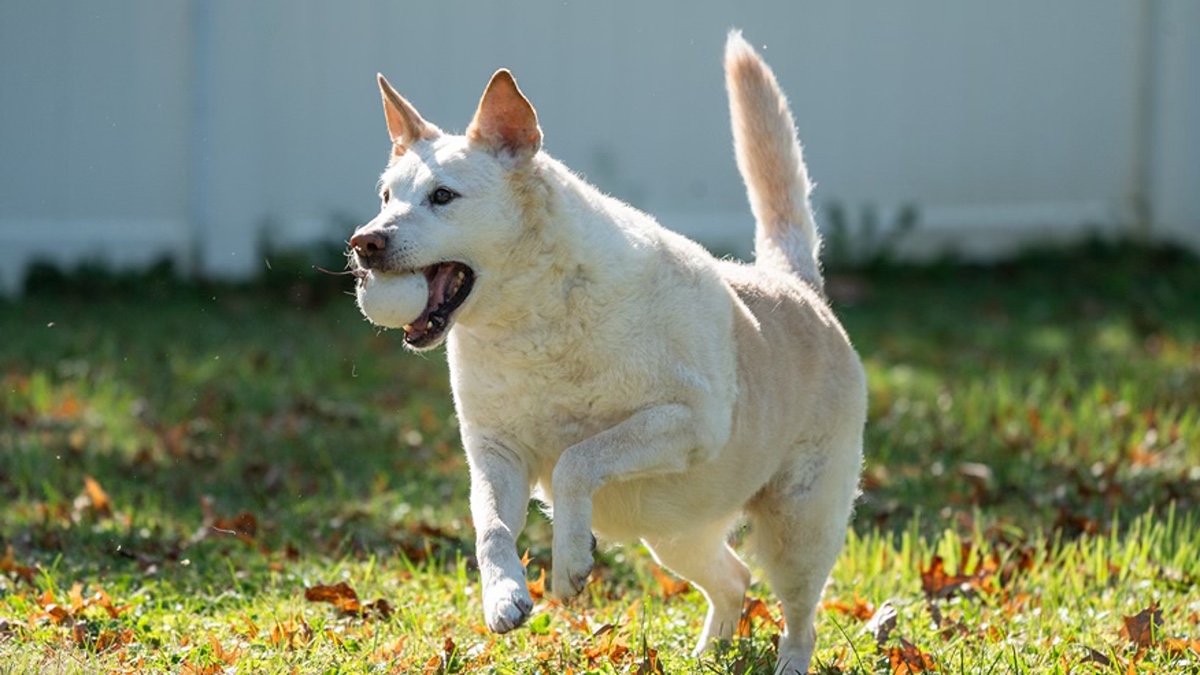Fetch, kitty! New research shows that cats are more eager to retrieve than you might think
Mikel Delgado, a senior research scientist in Purdue University’s College of Veterinary Medicine, has had pet cats most of her life. So she was excited when her new kitties began doing something her previous cats had never done: playing fetch. The three cats, sisters adopted from an animal shelter, would all bring her toy mice to throw, then dash off to retrieve them.
“It was an interesting surprise,” said Delgado. “It’s very cute.”
It got her thinking: Was fetching really such an unusual behavior for cats? So Delgado delved into the research with her Purdue colleagues Judith Stella, senior research scientist, and Candace Croney, professor and director of the Center for Animal Welfare Science, along with James Serpell from the University of Pennsylvania’s School of Veterinary Medicine. Using data previously gathered by Serpell, they looked at how frequently cat fetching was reported by pet owners and tried to determine what characteristics made cats more or less likely to fetch.
Their analysis showed that more than 41% of cats do fetch, as compared to about 78% of dogs. For both cats and dogs, fetching was more likely among younger males. Having poor health and living with dogs made fetching less likely for both cats and dogs.
The survey data included 8,224 cat owners and 73,724 dog owners.
Some of the findings were expected. It’s well known that certain dog breeds are more likely to fetch, especially those bred for retrieving or herding tasks — golden retrievers, Labrador retrievers, German shepherds, etc. — and the team’s analysis confirmed this. These dogs are used to working with humans and enjoy the back-and-forth interactions. Breeds that show low trainability — Great Pyrenees, Chihuahuas and greyhounds, for example — are less likely to fetch.
As previous studies have hinted, cat breed also affected fetching. Breeds originating in the Far East, such as Burmese, Siamese and Tonkinese, fetch more often than domestic longhairs, for example.
“That’s much harder to explain,” Delgado said. Dogs have been bred to help humans in various ways, but cats have been bred mostly for appearance and companionship.
“Some say cats have weaseled their way into our hearts without having to do much, and we haven’t changed them much,” she said. “We don’t ask cats to fetch our slippers or guard sheep or protect our homes.”
One hypothesis is that cats who fetch are more likely to be sociable, which could account for breed differences. “Siamese cats are highly interested in people,” Delgado said.
Indoor cats are much more likely to fetch than outdoor cats. It’s possible that this is because indoor cats have fewer opportunities for hunting, and playing fetch scratches the same itch, Delgado said.
The team’s findings were published Sept. 2 in the journal PLOS One. The paper is cheekily titled “Making Fetch Happen: Prevalence and Characteristics of Fetching Behavior in Owned Domestic Cats (Felis catus) and Dogs (Canis familiaris)” — a reference to the classic comedy “Mean Girls.”
Delgado said the research helps show how cats are indeed socially engaged with humans.
“Bringing a toy to us is a social request,” Delgado said. “A lot of people mischaracterize cats as being aloof or independent, and in truth they really do enjoy these interactions with their owners.”
FAST FACTS ABOUT FETCH
- About 41% of cats and 78% of dogs fetch.
- Cat breeds most likely to fetch include Abyssinians, Bengals, Siamese and Siberians.
- Dog breeds most likely to fetch include Labrador and Golden retrievers, border collies, Australian shepherds, German wirehaired pointers, and English cocker spaniels.
- Both male cats and dogs fetch more often than females.
- Younger animals fetch more frequently.
- Living with a dog reduces fetching for both cats and dogs.
About Purdue Agriculture
Purdue University’s College of Agriculture is one of the world’s leading colleges of agricultural, food, life and natural resource sciences. The college is committed to preparing students to make a difference in whatever careers they pursue; stretching the frontiers of science to discover solutions to some of our most pressing global, regional and local challenges; and, through Purdue Extension and other engagement programs, educating the people of Indiana, the nation and the world to improve their lives and livelihoods. To learn more about Purdue Agriculture, visit this site.
About Purdue University
Purdue University is a public research university leading with excellence at scale. Ranked among top 10 public universities in the United States, Purdue discovers, disseminates and deploys knowledge with a quality and at a scale second to none. More than 106,000 students study at Purdue across multiple campuses, locations and modalities, including more than 57,000 at our main campus locations in West Lafayette and Indianapolis. Committed to affordability and accessibility, Purdue’s main campus has frozen tuition 14 years in a row. See how Purdue never stops in the persistent pursuit of the next giant leap — including its integrated, comprehensive Indianapolis urban expansion; the Mitch Daniels School of Business; Purdue Computes; and the One Health initiative — at https://www.purdue.edu/president/strategic-initiatives.
Media contact: Devyn Ashlea Raver, draver@purdue.edu
Sources: Mikel Delgado, delgad75@purdue.edu
Agricultural Communications: Maureen Manier, mmanier@purdue.edu, 765-494-8415
Journalist Assets: Images and/or Videos, Google Drive





